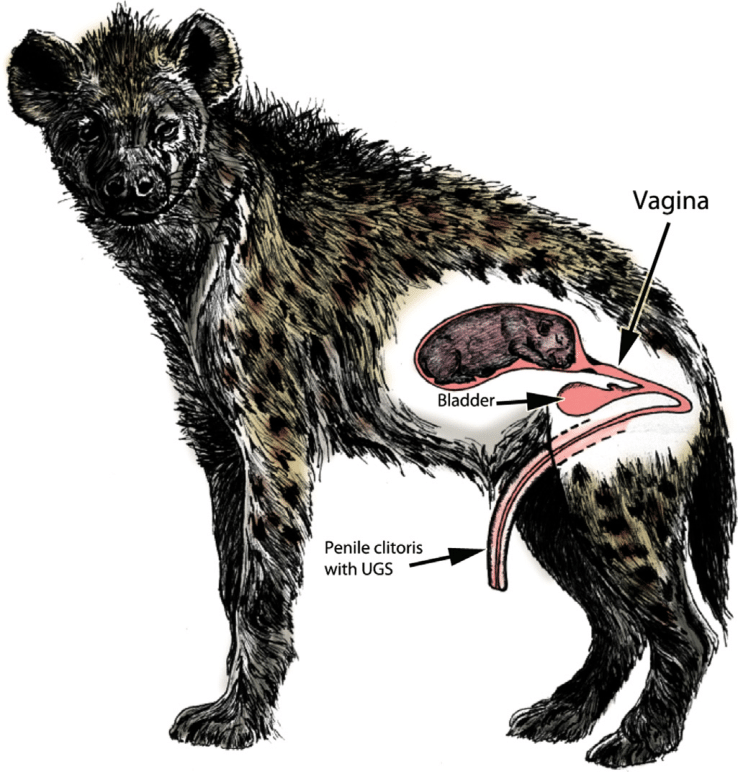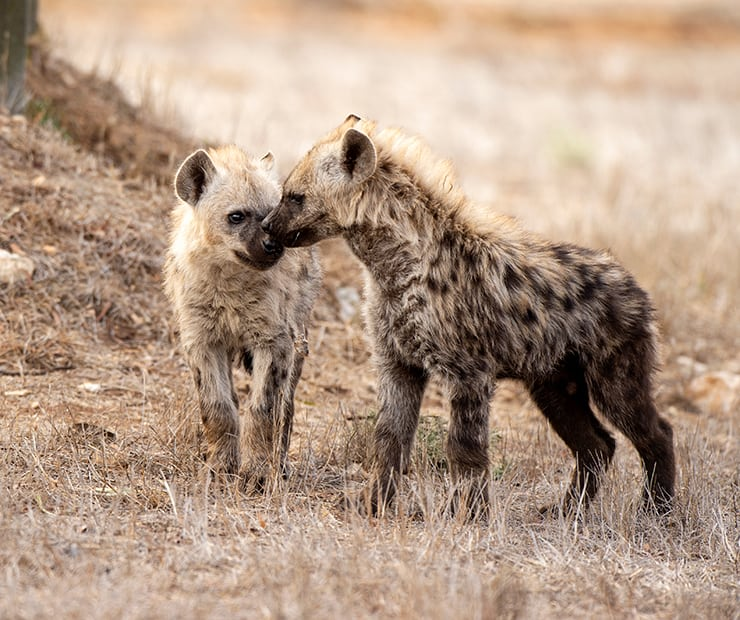Nature is full of fascinating and sometimes brutal adaptations, but few are as shocking as the birthing process of the spotted hyena. You might think childbirth is a universally painful experience, but hyenas take it to an entirely new level.
Female hyenas have one of the most unusual reproductive anatomies in the animal kingdom—what appears to be a penis is actually an elongated clitoris, known as a pseudo-penis. This rare adaptation makes mating, birth, and survival incredibly difficult for both mother and cubs.
Let’s dive into the science, struggles, and evolutionary mysteries behind why hyenas experience one of the most challenging births in the wild.
Hyenas’ Unique Reproductive Anatomy: A Bizarre Evolutionary Twist

The female spotted hyena (Crocuta crocuta) is unlike any other mammal when it comes to reproduction. Unlike most female mammals, hyenas have no external vaginal opening. Instead, their labia are fused together, forming a pseudo-scrotum, and their clitoris is elongated into what resembles a fully functional penis.
This means that both mating and giving birth happen through a narrow, tough, and inflexible canal—a structure that poses serious risks to both mother and cubs.
But why would evolution favor such an extreme adaptation? The answer lies in hyena social structure and dominance.
The Link Between Dominance and Reproductive Anatomy
Hyenas live in strict matriarchal societies, where females outrank males in dominance. The unusual reproductive anatomy is believed to be an evolutionary adaptation linked to social hierarchy.
- A Display of Strength: A larger pseudo-penis might act as a dominance signal, making it clear which females hold power in the clan.
- Hormonal Influence: Female hyenas have higher testosterone levels than males, leading to increased aggression and dominance over the pack.
- Mating Challenges: Males must earn the right to mate, as females control copulation with their complicated anatomy.
Video : Hyenas’ Brutal Birth: The Most Painful Labor in the Animal Kingdom
While this system gives females power, it comes at a terrible cost when it’s time to give birth.
Why Giving Birth Is So Dangerous for Hyenas
Imagine trying to push a newborn through a passage too small, too rigid, and highly prone to tearing. That’s exactly what female hyenas go through every time they give birth.
Here’s what makes hyena birth so deadly:
- A Super Tight Birth Canal
- The pseudo-penis acts as the only birth canal, but it is long, narrow, and lacks the elasticity of a normal vagina.
- This makes labor extremely difficult and painful, with a high chance of the tissue tearing.
- First-Time Mothers Face the Worst Risks
- Many first-time mothers do not survive the birthing process due to severe ruptures.
- Those who do survive often suffer from long-term damage to their reproductive organs.
- High Cub Mortality Rate
- A staggering 60% of hyena cubs suffocate before they are fully delivered.
- Since the birth canal is so tight, cubs often become trapped and die before they can emerge.
- A Painful Recovery Process
- After birth, the pseudo-penis often ruptures completely, forcing it to heal over time.
- Mothers suffer weeks of pain and vulnerability while their bodies recover.
Despite these brutal challenges, hyenas continue to thrive, and their unique reproductive system has remained largely unchanged for millions of years.
How Do Hyenas Mate? The Struggles of Reproduction

If you think birth is difficult for hyenas, mating is no easier. Males must overcome significant anatomical and social obstacles just to reproduce.
- Males Are Submissive to Females
- Unlike in many species where males dominate, male hyenas are the weaker sex in both power and ranking.
- They must approach females cautiously, often displaying submissive behavior to gain approval.
- Navigating the Pseudo-Penis
- Since females have no traditional vaginal opening, males must carefully maneuver through the pseudo-penis to copulate successfully.
- This requires both patience and precise positioning, making it one of the most complex mating processes in the animal world.
- Only the Strongest Males Get to Reproduce
- Males don’t fight each other for dominance like in other species. Instead, they must earn the female’s trust over time.
- Females choose mates based on persistence, patience, and respect, ensuring only the most determined males pass on their genes.

Given how dangerous and inefficient the reproductive process is for hyenas, one might wonder why evolution hasn’t corrected this issue.
The answer lies in survival strategy and social dynamics.
- Matriarchal Control Guarantees Stronger Cubs
- By limiting mating to only the most persistent males, female hyenas ensure that their cubs inherit strong genetics.
- This method prevents weaker genes from spreading, keeping the species robust.
- Higher Testosterone Helps With Survival
- The same high testosterone that makes birth difficult also makes female hyenas stronger and more aggressive.
- This aggression helps protect their cubs and maintain dominance in their environment.
- Fewer Cubs = More Resources
- Since many cubs don’t survive birth, the ones that do are often given more attention and resources.
- This ensures the strongest cubs make it to adulthood, increasing the clan’s overall survival rate.
The Resilience of the Spotted Hyena
Despite their brutal birthing process, hyenas have thrived for millions of years. Their ability to adapt, dominate, and survive proves just how powerful evolutionary trade-offs can be.
- They are among Africa’s most successful predators, competing with lions for food.
- Their clans are ruled by powerful females, ensuring only the strongest members survive.
- They have some of the most advanced social structures in the animal kingdom, making them highly intelligent and strategic.
Video : The Most Extreme Births In The Animal Kingdom
Conclusion: Nature’s Ultimate Test of Survival
Hyenas are proof that nature often prioritizes survival over comfort. Their unique reproductive anatomy, extreme birthing challenges, and dominance-driven society have allowed them to thrive despite overwhelming odds.
While their birth process remains one of the most painful and deadly in the animal kingdom, it also ensures that only the strongest females and cubs survive.
So the next time you see a spotted hyena, remember—they’re not just fierce scavengers. They’re survivors of one of evolution’s toughest reproductive challenges.
I Witnessed Man Demanding His Wife Pay $800+ for Him and His Friends – I Took Cold-Stone Revenge on Her Behalf

Eight hundred dollars plus. That’s what Jack’s “boys’ night out” bill came to, and he expected his wife, Lora, to foot it. Waitress Melanie, witnessing Lora’s despair, concocted a bold move to ensure Jack’s night didn’t end as he planned.
Ten years. That’s how long I’ve been slinging plates at one of the fanciest restaurants downtown. You see all sorts of folks in this line of work, couples on first dates practically glowing, families celebrating birthdays with sticky-fingered toddlers, and the occasional business lunch that looks more like an interrogation than a meeting. But nothing could have prepared me for what I witnessed the other night…

A waitress going about her usual workday with a warm smile at an elite restaurant | Source: Midjourney
There used to be this couple, Jack and Lora, who were regulars. Cute as a button, always splitting the bill with a smile. They’d come in once a week, order the same decadent chocolate cake for dessert, and steal glances at each other like teenagers.
Lately, though, things had changed. The smiles were gone, replaced by a tense silence that hung heavy between them. And for the past few months, it was always Lora stuck holding the bill folder at the end of the night.

A couple eating in a restaurant | Source: Pexels
Jack, on the other hand, seemed to be indulging in a spending spree. Every time he came in, it was like a parade of the most expensive cuts of meat and bottles of wine you could imagine.
And guess who always ended up footing the bill? Lora, looking increasingly pale and drawn, would swipe her card quietly.
This particular rainy night, though, things went up a whole new level of ridiculous. Jack waltzed in with a gaggle of eight loud, boisterous friends, announcing like a king that it was his “treat.”

A gang of men entering an elite restaurant | Source: Midjourney
They ordered enough burgers and steaks to feed a small army, and while it was all fun and games for them, a knot of worry tightened in my stomach when I didn’t see Lora walk in with them.
Just as I was about to check if she was coming, she arrived, looking like she’d just run a marathon. Her eyes were red-rimmed and her steps faltered slightly as she approached the group.
Jack barely glanced up when she sat down, too busy barking orders at me to refill their drinks.

A sad woman holding her purse | Source: Midjourney
As the night wore on, I cleared away empty plates, my ears pricked towards their table. That’s when I caught a snippet of their conversation that made my blood run cold.
“I won’t pay this time,” Lora told Jack, laced with a tremor I’d never heard before. “Jack, I’m serious.”
He just chuckled. “Sure, babe. Don’t worry your pretty little head about it. I’ll take care of everything.”

A man smiling | Source: Midjourney
Easy for him to say, I thought, fuming silently.
But when the bill arrived, a hefty sum that hovered just north of $800, and Jack shoved it straight into Lora’s hand.
The way her face drained of color, the tears welling up in her eyes as Jack just kept shoving that damned bill at her, felt like some kind of cruel joke.

A bill on the table | Source: Midjourney
Lora bolted for the restroom, excusing herself. I scurried after her, and just as I reached the doorway, a muffled yell exploded from inside.
“So, now I earn 25% more than him and have to pay for all his buddies?! This is RIDICULOUS!” Lora was crying into the phone. “How can he demand I foot the bill all the time? This is so unfair!”
This wasn’t just about money; this was about control. And I wasn’t going to let him bully her like that.

A woman walking away | Source: Pexels
Her tearful phone call echoed in my ears. Taking a deep breath to steady my nerves, I approached Lora as she emerged from the restroom, dabbing her eyes with a crumpled napkin.
“Lora,” I said, “are you alright? Is there anything I can do?”
Her eyes welled up again. “Jack keeps insisting I pay for everything,” she choked out. “I can’t afford to do this all the time!”

An extremely upset woman | Source: Midjourney
There it was, the confirmation of what I’d already suspected. My heart ached for her. This wasn’t right.
But before I could offer any further words of comfort, an idea sparked in my head, a risky one, but maybe, just maybe, it was the only way out for her.
My mind raced. Here I was, a waitress who barely made enough to scrape by in this expensive city, about to potentially risk my job to help a customer.

A worried waitress | Source: Midjourney
But seeing the helpless fear in Lora’s eyes, the way Jack treated her like a walking ATM, I knew what I had to do.
“Listen,” I whispered, “Here’s what we can do. When I come back, pretend you’ve gotten an urgent call and leave right away. Don’t worry about the bill, I’ll handle it.”
Confusion flickered across Lora’s face for a brief moment, but then a spark of hope ignited in her eyes.
“Are you sure?” she whispered back. “What about your job?”

A distressed woman | Source: Midjourney
I squeezed her hand reassuringly, a silent promise passing between us. “Don’t worry about me,” I said. “Just trust me.”
She hesitated for a beat longer, then with a nervous nod, she reached for her phone and started tapping away, approaching her table.
My heart hammered in my chest as I retreated back towards the kitchen, praying my plan wouldn’t backfire spectacularly.

A restaurant kitchen | Source: Midjourney
A few minutes felt like an eternity as I battled the urge to peek out from the kitchen. Taking a deep breath, I plastered on my brightest smile and approached their table.
Jack, still engrossed in conversation with his buddies, didn’t even look up as I cleared my throat.
“Excuse me, sir,” I began, my voice loud enough for everyone at the table to hear. “The manager just informed me that there’s been a bit of a mix-up with your reservation.”

A waitress smiling | Source: Midjourney
Jack puffed out his chest like a rooster about to crow. “What mix-up? We made a reservation for nine just fine.”
“Well, sir,” I continued, my voice dripping with fake sympathy, “unfortunately, it appears there was a double booking for your table tonight. We have another large party arriving shortly, and they specifically requested this booth.”
Jack’s face contorted in disbelief. His “friends,” sensing trouble brewing, started shifting uncomfortably in their seats, their animated chatter dying down to a low murmur.

A startled man looking up | Source: Midjourney
“But… but we ordered already,” Jack stammered, his attitude taking a noticeable dip as he glanced at the mountain of barely-touched food.
“I understand, sir,” I said, my voice firm but polite. “However, since the reservation was made under a different name, we wouldn’t be able to accommodate you at this table any longer.”

A waitress smiling at someone | Source: Midjourney
Jack’s bluster faded, replaced by a panicked desperation.
He looked around the restaurant wildly, hoping for a miracle. There were no empty booths big enough for his group, and the scattered tables weren’t exactly ideal for the image he was trying to project.
“Can’t we just move to another big table?” he pleaded

A man pleading | Source: Midjourney
“Unfortunately, sir,” I replied apologetically, “we’re completely booked tonight. The best I can offer is to pack your food to go, or perhaps…” I paused dramatically.
“Perhaps, you and your friends could head over to the bar down the street. They have plenty of space for large groups.”
Jack’s face turned the color of a well-done steak. He knew that bar — it was a dive known for its greasy comfort food and cheap beer, a far cry from the upscale atmosphere he’d been trying to impress his “friends” with.

A waitress talking to someone | Source: Midjourney
Just then, as if on cue, Lora “remembered” her “urgent call” and stood up, feigning panic.
“Oh my gosh, I completely forgot!” she exclaimed, her voice laced with manufactured worry. “I have an important client meeting. I have to leave right away!”
With a quick “thank you” to me and a pointed look at Jack that spoke volumes, she grabbed her purse and walked out, leaving a stunned and defeated Jack behind.

A woman storming out | Source: Pexels
His “friends,” catching the drift, started making excuses for their own “sudden emergencies.” One by one, they slunk out, abandoning their leader like rats fleeing a sinking ship.
Jack, now completely alone with the remnants of his overpriced meal and the colossal bill, finally realized the trap he’d fallen into.
“But… but the bill!” he stammered, his voice high-pitched and frantic.

A man gaping in shock | Source: Midjourney
I shrugged apologetically. “Unfortunately, sir, you’re responsible for the bill for the entire party.”
Jack sputtered and argued, his face turning from red to purple. He demanded to speak to the manager, but I politely informed him that he was busy.
In the end, with no Lora to share the financial burden and his “friends” long gone, Jack was forced to pay for the entire meal, his grand night out with the guys dissolving into a bitter aftertaste of loneliness and a hefty bill.

A shocked man looking around | Source: Midjourney
The look on his face as he begrudgingly swiped his card was pure satisfaction.
The next day, just as the lunch crowd started trickling in, the door opened and Lora walked in. She scanned the room until her eyes landed on me, and she bee-lined straight for my station.

Man getting his card swiped | Source: Pexels
“Melanie!” she exclaimed, her voice filled with warmth. “I just wanted to thank you again for everything you did last night. You saved me more than just money, you saved me from…” she trailed off, her voice catching slightly.
“From being bullied,” I finished for her, my voice soft. We both knew the truth.

A waitress with a radiating smile plastered on her face | Source: Midjourney
Lora nodded, her eyes welling up. She reached into her purse and pulled out a crisp hundred-dollar bill.
“Here,” she insisted, pushing it towards me. “This is for you, for your trouble.”
I hesitated. I hadn’t done it for the money, but seeing the genuine gratitude in Lora’s eyes, I couldn’t refuse.

A woman staring at someone | Source: Midjourney
“Thank you, Lora,” I said, accepting the bill with a smile. “But honestly, seeing the look on Jack’s face was reward enough!”
We both chuckled, the shared experience creating a sudden bond between us.
“So,” I said, a mischievous glint in my eyes, “what are you going to do with all that extra money you saved last night?!”

A waitress with a mischievous glint in her eyes | Source: Midjourney
Lora’s eyes sparkled. “Well,” she said, leaning in conspiratorially, “I was thinking of treating myself to a fancy spa day. Maybe even a massage.”
We both burst out laughing, the tension of the previous night completely dissolved.
As the day wore on, I couldn’t help but think about Lora and the countless others who might be stuck in similar situations. Maybe, I thought, my little act of rebellion could inspire someone else to stand up for what’s right.

A waitress lost in deep thought | Source: Midjourney
Lora’s ordeal made me realize that sometimes, the most valuable things we can offer aren’t on the menu. Sometimes, the best service we can provide is a little bit of kindness, a dash of courage, and a whole lot of support.
So, people, ever witnessed someone get bullied like that? What would you have done?

A waitress with a calm look etched on her face | Source: Midjourney



Leave a Reply